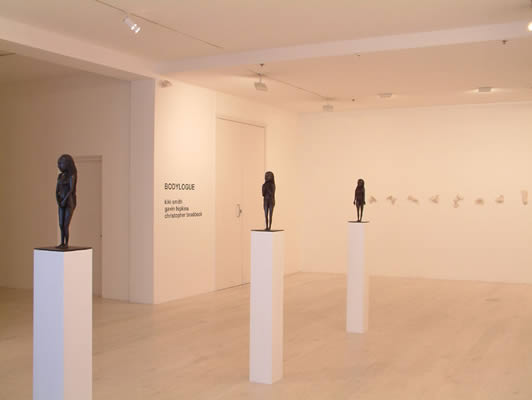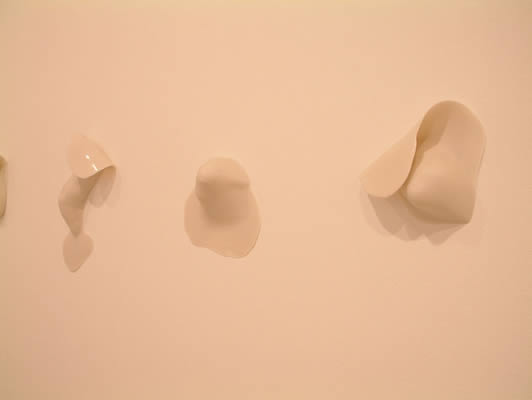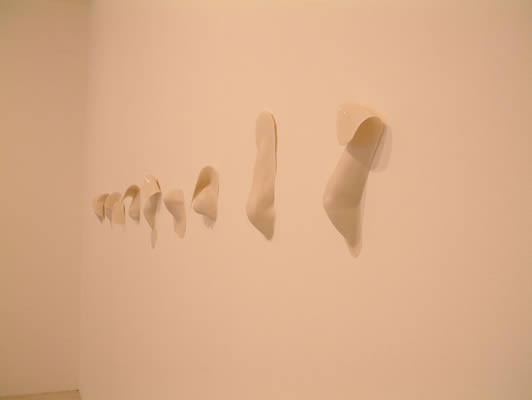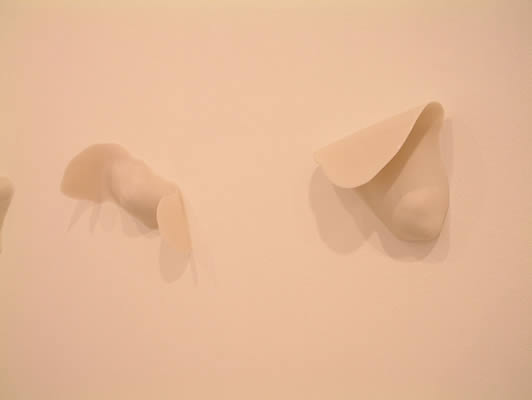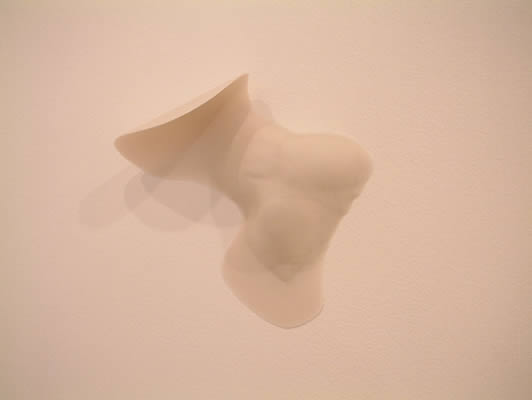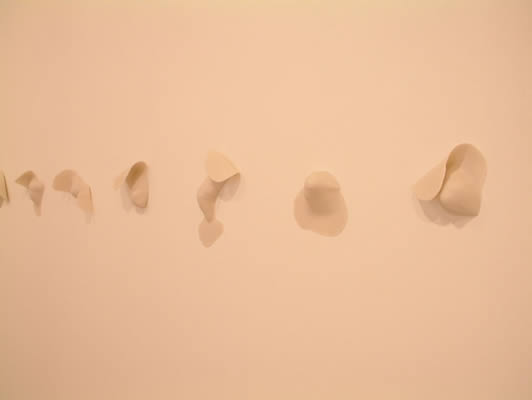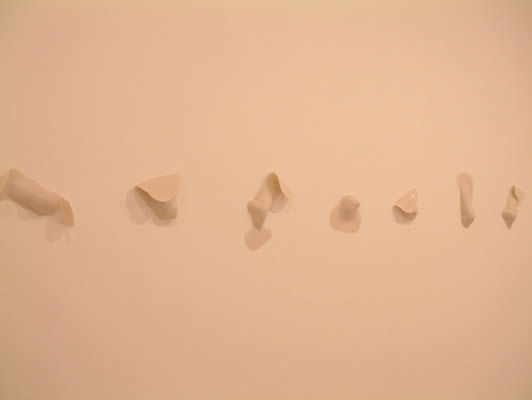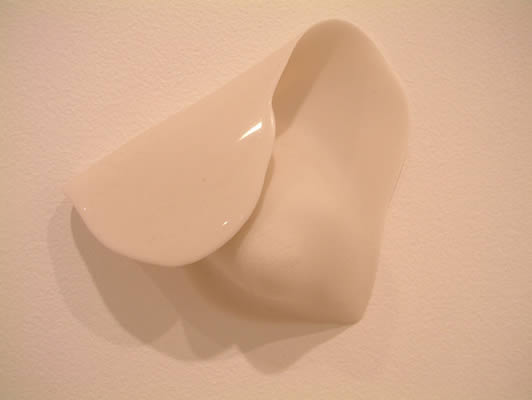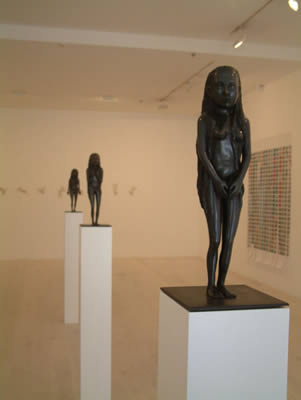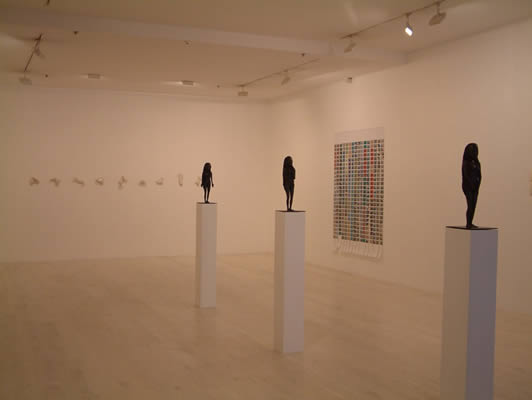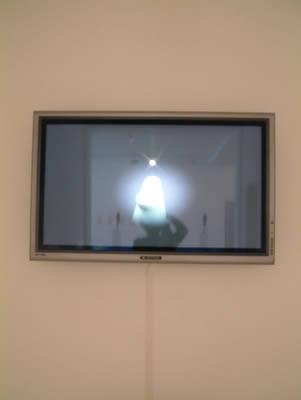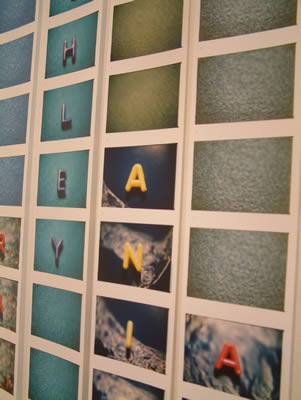Bodylogue (2003)
Christopher Braddock Nine Imprints from the Fleshly Worn Series (2003) Chartwell Collection, Auckland Art Gallery
Christopher Braddock, Gavin Hipkins and Kiki Smith
21st October – 15th November 2003
Gow-Langsford Gallery, Auckland. BODYLOGUE is a curated project by Chris Braddock exploring sets and
groups of bodies. From gestures, to porn-star names and body-bits, BODYLOGUE collects fragments of the body and body-types for collection and display.
BODYLOGUE: the essay
Kiki Smith
Gavin Hipkins
Christopher Braddock
Gow-Langsford Gallery, Auckland. October – November 2003
There’s an old party trick designed to create your own porn-star name: choose the name of your first pet and the street you lived in at the time. Gow-Langsford Gallery staff produce some glowing examples: Muffy Shackleton, Pussy Sentinel, Mitzi Milais and Lucky Karaka. This word-game sets the scene for BODYLOGUE as it explores sets and groups of bodies. New syntaxes logue associations from memory and history, providing a rich terrain for overlapping typologies resulting in new frameworks of ordering. From gestures, to naming bodies and body-bits, BODYLOGUE collects fragments of the body and body-types, for collection and display. The BODYLOGUE artists share a fascination with sets and multiples. To LOGUE suggests recording, listing and itemizing. These preoccupations share characteristics of the archive that seeks inherent structural order; seemingly infinite multiplicity; serialisation and a desire for comprehensive categorisation.
What interests me most about the porn-star names is that they are so easily identifiable as a known typology, yet they are so random: they have so little to do with the endgame. It’s always shocking, how collections of types of things do more than prop up similarities, but provoke differences. One might expect continuity: a collection of things that exclude interpretation in favour of narrowed and existing conditions, but discontinuity follows as does a plethora of possibilities.
Gavin Hipkins’ The Den (A), 2003, based on the names of famous porn-stars that begin with the letter A, presents plastic kid’s letters overlaid against second-generation photographs of the earth’s surface from outer space. A dilemma in understanding Hipkins’ work is the nonsense of the game. Like the construction of the porn-names themselves, what do these layers have to do with each other? Nothing and everything. As with some of his recent projection-strip works such as The Gulf (Redhead), 2001, The Den (A) suggests a kind of mnemonic experience that can be related back to Aby Warburg’s Mnemosyne Atlas, 1925-29. Warburg montaged together more than sixty panels comprising over a thousand photographs in an attempt to chart traumatic historical experience from Classical Antiquity in Renaissance painting. Warburg’s mnemonic methodology offered a challenge to the hierarchical and compartmentalised archive of the discipline of art history. It was this attempt to construct social memory by means of a broad range of photographic imagery, from monumental frescoes to stamps and magazine pictures, that is of interest here. In Hipkins’ work an extreme heterogeneity of subject and spatial relationship is contrasted against the paradoxical homogeneity of photography’s ability to reduce size and scale, given formal rigour by the fall and seriality of The Den’s (A)’s projection-strips.
These issues of difference and similarity within the notion of the archive are echoed in Braddock’s series of flocked works mimicking museum display-case bases. The recessed forms, calculated from three key modules, suggest an alphabet in reverse. They are reminiscent of apparatuses of display: the recesses in which artifacts might rest. Entitled Bunking Off, the series solicits ideas of truancy: an absence of the body. His recent works including Repository, 2001, and Push, 2003, hint at recent patterns in ethnographic practice that propose the study of collection methods and patterns of display as a valuable area of research in its own right: how things are collected as well as what. Bunking Off reverses the dilemma: so often accustomed to negotiating the prejudices of display, the viewer is confronted here with the display system as a trace of the artifacts. While the absent archive suggests congruence in its nod to minimalist repetition and serialisation, the viewer is invited to complete the task in a plethora of privately imagined endgames.
As BODYLOGUE shifts from medium to medium an underlying framework is that of multiplicity, both as a technology and in the syntax that results from serialisation. While such multiples are associated with loss of aura of the original, photography as the queen of reproduction presents a monumentalising and reproducing capacity that displaces that auratic cult-value. In this light, photography has been a catalyst for a discussion where reproduction is understood as both imitation and as a trace of the thing imitated, involving a two-layered notion of mimesis.
These relationships of imitation and trace are continued by Hipkins in a Celtic mantra of the Teat Prayer forming the audio to The Host Part 2. This incantation adapted from the late 19th & early 20th Centuries offers infinite multiplicity in its naming: Teat of Jack; Teat of Mary; Teat of Rebecca etc… Hipkins overlays female and male voices where the endless list of names adheres to strict alphabetic order. The DVD echoes The Colony, 2002, in that he has cultivated a strange collection of body-like polystyrene cones and balls, the frame shifting at each incantation. Religious mantras act as a kind of mnemonic background that allows the mind to empty the self’s ego in order to be filled by the divine presence. The repeated mantra is both an imitation and a trace of the thing imitated: it is both to copy a divine order and offer a palpable connection to the aura of the original.
The Teat of Mary is both sexualised body-part and venerated as signifier of Christ’s humanity and nutrition, the flow of milk pulling us into a dilemma of sacred and profane dimensions. Catholicism’s capacity to physically embody spiritual ideas is pivotal to The Host Part 2 and to the work of Kiki Smith. Her 2002 trio entitled Mudra, Heart and Baby Doll take their cue from earlier sculptures such as Blue Girl, 1998, and notably, Mary Magdalene, 1994. Following her interest in Catholic iconography, the figures display a mix of exposed childlike vulnerability and meditative rigour. Her depictions of long and tangled hair are seen by Smith as the unfolding of the head, representing the artist herself and a resistance to cultural norms of femininity. The iconography, reminiscent of Donatello’s Mary Magdalene, is employed to signal a fragmentation of traditional dichotomies of mind/body and spirit/nature inherent in mainstream philosophical discourses just as the depiction of the full-figure nude is employed as a means to critique much of late modernism’s mainstream conventions. Saint Mary Magdalene, in her sexual subversiveness, is a pivotal figure in addressing such dichotomies of rationalism and the body, particularly given her service and devotion to the figure of Christ.
BODYLOGUE places Smith’s three bronze female-nudes down the centre of the gallery in a semaphore of gesture mimicking the three monkeys: ‘see no evil’, ‘hear no evil’ and ‘speak no evil’: lets call it mnemonic semaphore. In Smith’s case the hands either cover the genitals, the breasts or reach into the sky. As such they constitute a set of moral gestures, a kind of pedagogy of behaviour. Her works such as Hand in Jar, 1983, and Glass Stomach, 1985, inaugurated an exploration of the body in fractional parts: body-organs, parts and the significance of the body as a system of coded signs. Smith’s figuration provokes a startling collision between sentimentalism, vulnerability and assertion. Like the porn-star word-games and concomitant porn industry, these works stretch the body’s limits, both physical and moral.
This stretch and strain is given material veracity in Braddock’s nine Imprints from the Fleshly Worn Series which index the artist’s right wrist and elbow. He has pressed these body-parts into clay and poured the cavities with white silicone rubber, overflowing at the limits of the impression. There is a suggestion here of the artist as ethnographer, collecting gestures – a set of body citations. If ethnography is understood as a published description based on fieldwork, these impressions offer the author as the field of enquiry: a kind of typology of one’s own everyday anatomy. It is argued that ethnobiograhies tell us stories about what people say about each other in local settings: the native gossip. Auto-ethnobiography comes close to gossip about oneself, not normally for publishing: one’s own informant. To collect one’s own gestures is to collate a subjective archive of bodily and emotional projections. Set in place here are the artifacts collected that are themselves the product and imprint of the archivist.
Kiki Smith’s trio share the marks of the self-portrait suggested by Braddock. Raising questions about where the membrane of the self stops and where it starts. The membranes of Braddock’s works literally overflow and fall from the walls challenging the idea of the self-contained limits of the body. Just as Hipkins’ porn-stars challenge the private and public identity of the sexual self. It is the photographic intensity and exactness of Braddock’s silicon body-casts that brings them into the realm of mimicry. These works engage in a sensuous mimesis of the artist’s body, that which Walter Benjamin took to be the compulsion to become the Other – the mimetic faculty. Michael Taussig describes mimesis as both “a copying or imitation, and a palpable, sensuous, connection between the very body of the perceiver and the perceived.”
As BODYLOGUE flips between the gestured-body, the named-body and the fragmented-body, the nature of mimesis is played out in all its complexity. In each of these works, Benjamin’s well-quoted exhibition value surpasses any original gesture. Multiplicity, expressed through serialisation and reproductive technologies, is played out within an arena of typological display and mnemonic phrasing where the archive poses its dominant pressure for containment and its desire for categorisation.
Caspar Millar
For references in this text see: Ahrens, C. (1998). All Creatures Great and Small: Kiki Smith’s Artistic Worlds. Hannover: Kestner Gesellschaft; Buchloh’s Atlas/Archive in Coles, A. (1999). (Ed). The Optics of Walter Benjamin. Black Dog Publishing; Posner, H. (1998). Kiki Smith. Boston: Bulfinch Press; Söderqvist’s Biography or Ethnobiography or Both? in Steier, F. (1991). (Ed). Research and Reflexivity. London: Sage Publications; Taussig, M. (1993). Mimesis and Alterity: A Particular History of the Senses. New York: Routledge.
